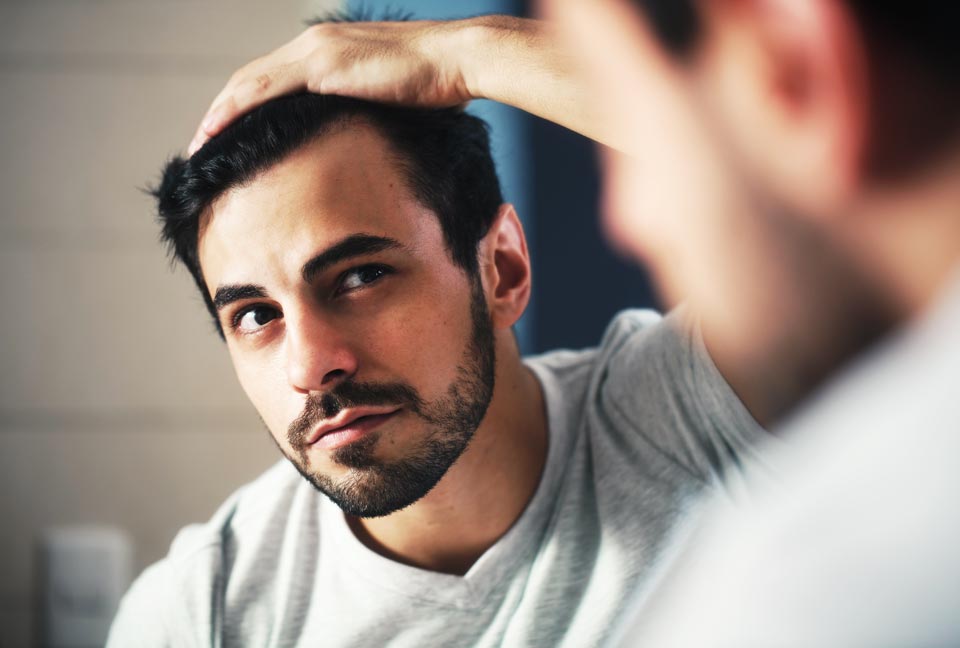Alopecia Areata

There are currently new therapy plans that combine the benefits of a mesotherapy approach with topical medication and of course the solution of oral medications like jak inhibitors with very promising results.
Alopecia Areata is a non-transmittable disease that causes hair to fall and because of its impact on image and appearance, it has a psychology toll on the patients. A common sign of Alopecia Areata is a roundish patch (visible or hidden) on the scalp. Alopecia Areata can be cured and hair can regrow, and an experienced dermatologist will primarily diagnose the case and will advise on the best therapy to help hair grow back again.
Each one of us has a different type of hair (straight and fine, straight and coarse, curly, wavy, coiled, etc). Each day we lose 80 – 100 hairs but on average, one can find between 100.000 and 150.000 hairs on a head, at different growth stages.
Hair growth stage duration changes according to age, nutrition and other factors that this is why a discussion with a dermatologist is important; a holistic therapy plan is much better.
The diagnosis for Alopecia is based on clinical examination : hair count /Dermoscopy and Trichogram so as to determine the number, the dispertion and the quality of the hair follicles.
A pull-test might also be necessary as well as a blood and hormonal test. The pull test known also as a 'traction test' is effective when telogen stage hair are gently pulled out to examine the location and spread of hair loss. It requires expertise as the result varies according to the type of hair follicles each person has.
Needless to write that if hormonal or other health imbalances are discovered, any treatment should start with that step first so as to facilitate the positive outcome of any later – additional treatment.
Effective diagnosis = Understand and Manage the causes & Avoid unnecessary treatments.
Treatments are divided into non-invasive and invasive. Non-invasive treatments include topical medication based on Minoxidil, a substance that has been proved effective with recent compounds to offer more comfortable properties, eg: non oily solutions.
Additional treatments that improve the effectiveness of a hair loss therapy plans include mesotherapy and Platelet Rich Plasma mesotherapy that help increase the concentration of nutrients as well as improve the microcirculation of blood in the targeted areas.
In all types of mesotherapy, a fine needle is used to inject the nutrients; however in the case of PRP mesotherapy, your own blood is used to create a concentrate of platelet-rich plasma protein, centrifuged to have the red blood cells removed.
We have already witnessed the results that mesotherapy treatments offer in cases of hair loss from day 1, although a quite satisfactory result will need between three and five treatments to be fully realised.
Men and Androgenetic Alopecia
Androgenetic alopecia when it appears in the male population, results into prominent hair loss in the vertex and frontotemporal regions and as one may conclude from the name of the disorder, has a genetic predisposition (with sons at a five-to-six-time higher relative risk if their fathers were balding) and develops only after puberty as a response to androgen.
It is important to start a supportive therapy plan the soonest possible towards delaying and reversing hair loss which if present, can be corrected only through an invasive method only, i.e. hair transplant.
Women and Androgenetic Alopecia
Although Androgenetic Alopecia affects primarily the white men population (half of the cases observed in men by their 50th year of age), it is also common in the women population, observed mainly after menopause.
In women, the hair loss pattern differs as it is observed between the frontal and the vertex of the scalp, as a thinning process that worsens by a stress – related factor that causes more hair to grow fast from the anagen phase to the telogen phase. The ‘Christmas Tree’ look is often linked to hormonal imbalances, polycystic ovarian syndrome and Thyroid disorders.
If you worry about a recent hair loss incident, do not delay your visit. It is important for your inner balance and confidence, to assess the symptom and the case towards an effective resolution.
